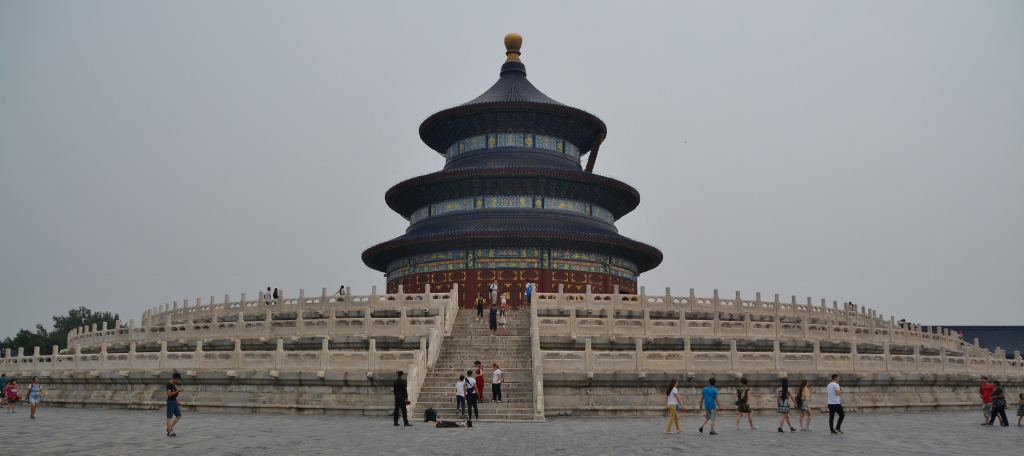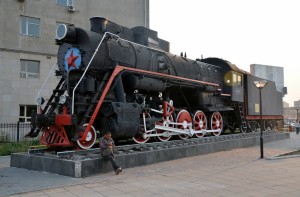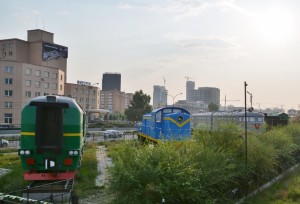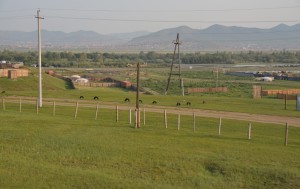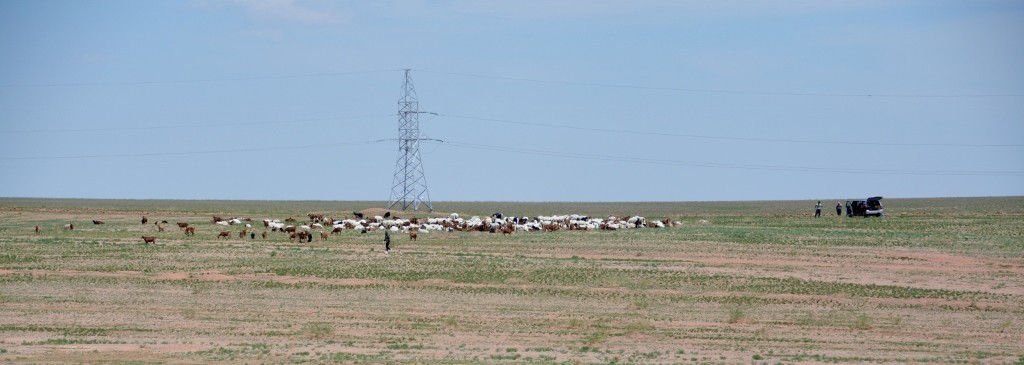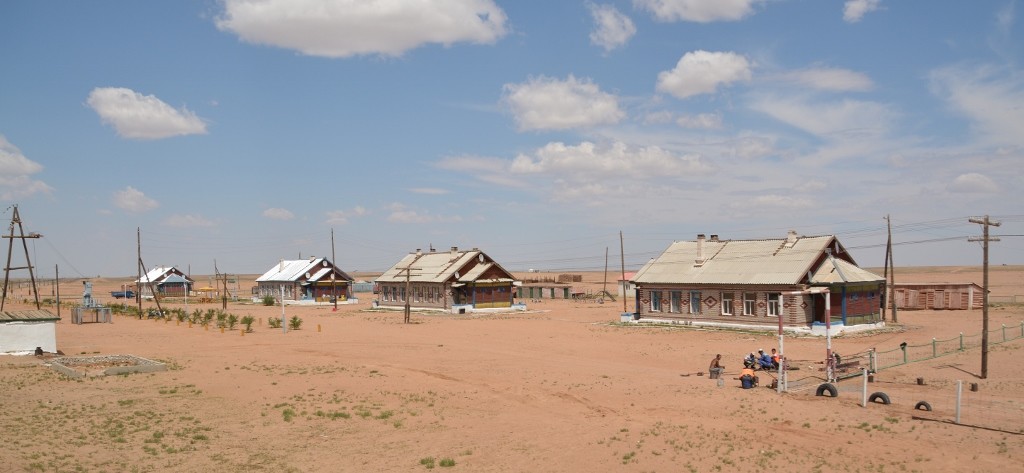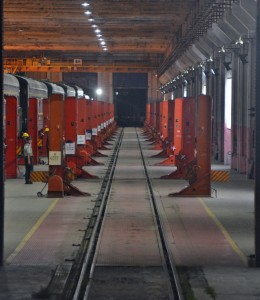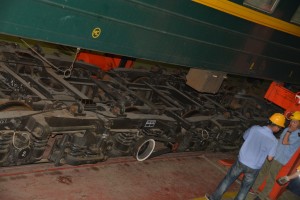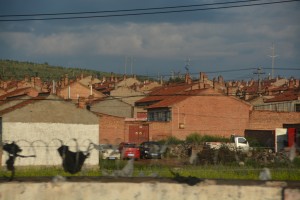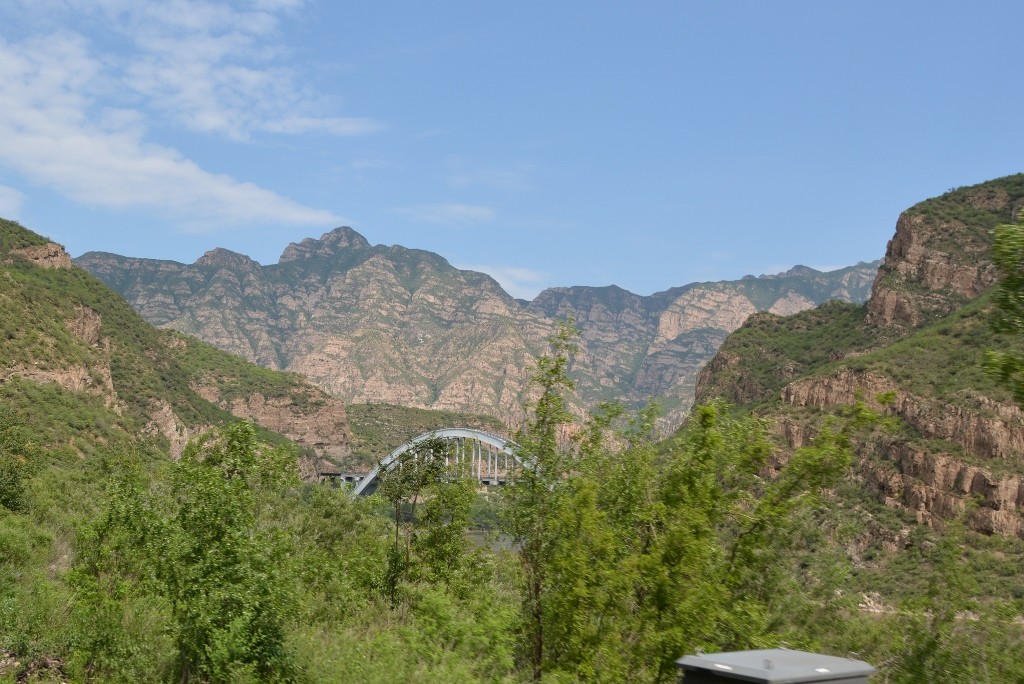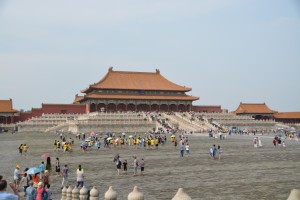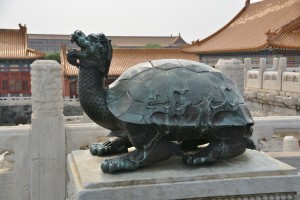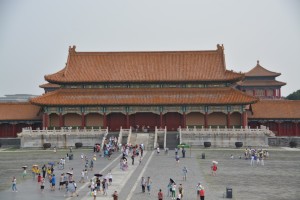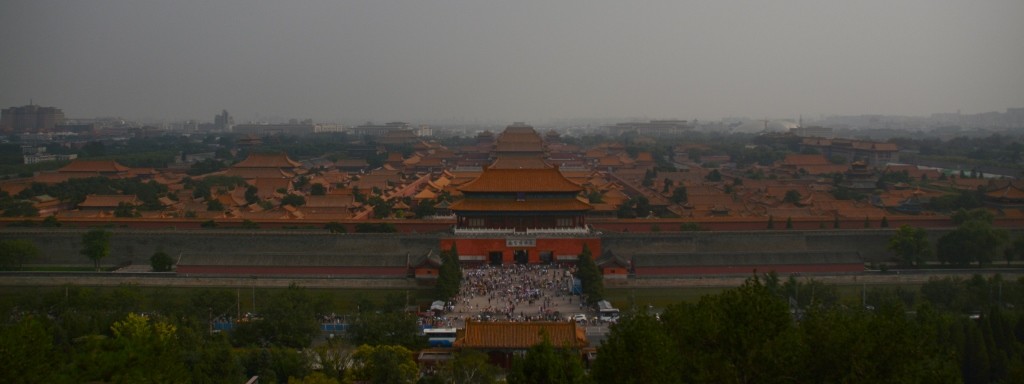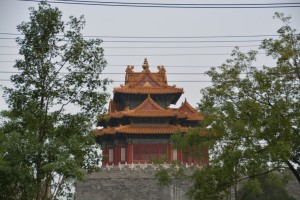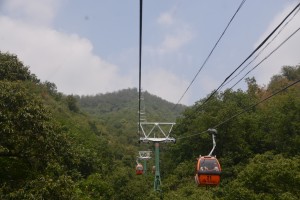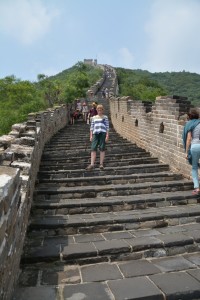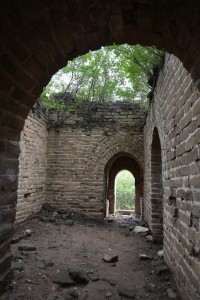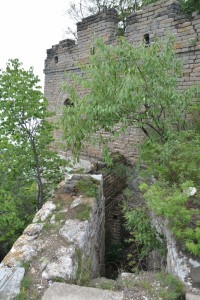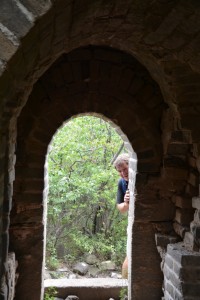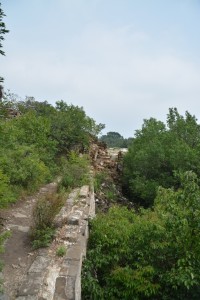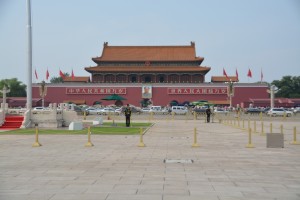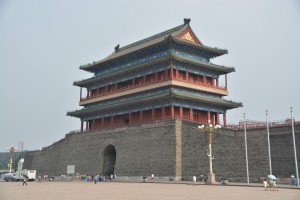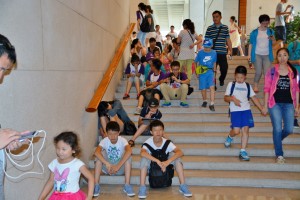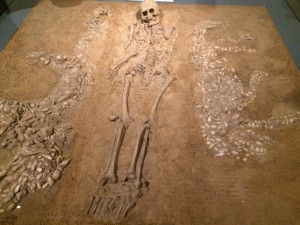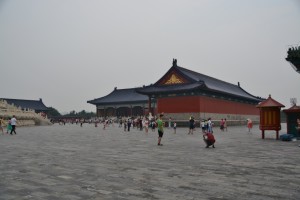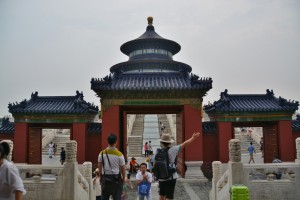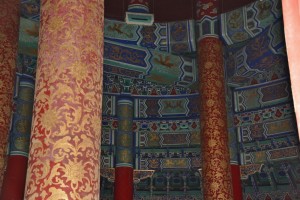The Kempinski Hotel seemed to have slipped into the local way of not getting things right. The check-out was a shambles, I was expecting John Cleese to appear any second. Eventually a taxi took us to the station. The driver wanted 25k in locals for what should have been 6 to 8. Bugger, I only had a 20k note and he had no change. How convenient!! I went to a shop and got change. These buggers just love to try it on.
Chinese crew check us onto the train. This one is a lot older than the previous ones. Bang on time it shudders its way out of the station. One thing they do well in this part of the world is preserve old train engines. All the way through we have seen various vintages from steam to electric engines on display around railway stations. There was a line up we saw further up the line on the way to the station. We roll or should I say shake east for a while before heading south.
The country side is really pretty with its deep wide green valleys dotted with gers, mobs of goats, sheep, yaks, cows and horses. These fourteen carriages must be the really, really slow train to China – it seems like it is hardly moving. Like the previous trains, toilets are locked at the stations as they drop their load straight onto the track, like they did in NZ forty years ago.
Since arriving in Ulan Bator there has been a blue haze hanging in the air making good photos impossible. This is apparently from some forest fires in Siberia. A few hours south we move into the Gobi Desert. This is gradual as the ground gets more sandy but apart from a couple of kilometres of sand it all has some sort of growth on it.
After 8 hours our first stop is Sainshand where we get off to stretch our legs. We are surprised by the number of people we run into on the platform that we had met on a previous leg of our journey – Imran and Sonalire are in the cabin next to us. Around six we head to the dining car for a meal. The old style car is the first one we have struck with people using it. It’s a set menu – a small salad followed by a soggy meat patty, rice and a piece of miniature broccoli. We get the bill = 46k each in locals or about 46 NZD. What a rip off! Obviously they don’t want to encourage repeat tourism. Or maybe the Chinaman running the place went to the same training place as taxi drivers go. When the average wage here is 400US a month they must have special “up the price” deals for tourists or the locals would starve.
There are many appealing things about the landscape and the friendliness of the happy looking people here. It’s almost like the tour operators are trying to stuff it all up.
We arrive at the border around 5pm. Soldiers stand at attention saluting as the train pulls in. Passports are collected, taken away, stamped and returned. A couple of hours later we cross the border to Erlian on the China side. Passports and forms are collected again. We are then shunted off to a big shed. Here the carriages are separated then lifted by four jacks with the Russian bogies staying on the ground. The Chinese bogies are pulled in on a wire rope pushing the Russian ones along out of the way. Pins are lined up and the carriages lowered down onto the new bogies and we are all set for China rail. During this process which is watched over by soldiers our passports are returned. The whole process is pretty efficient and took about an hour. We then had to wait around for a fair while before being shunted back to the station where we got to disembark and walk around the station for an hour or so. The doors to the street from the station are locked and officials quickly herd us back to the platform if we venture to far. There is no doubt a reason why we waited around here so long after the job was done but we will never know what it was.
It is around one am when we finally start our journey south into China.
Sylvia:
Friday 24 July
When we woke this morning the scenery was very different – much more mountainous and the villages tidier and very different architecture. As we got closer to Beijing we travelled through about 65 tunnels, interspersed with glimpses of mountains, lakes and rivers. It took quite a while to get to the station from the outskirts of Beijing as we passed many skyscrapers and houses all close together in the smoggy atmosphere. At one point we passed through a train station with about 10 tracks all with bullet trains on. We have travelled about 7826km from Moscow to Beijing, over roughly 5.5 days, our average speed has been less than 60kph. Admittedly some of that time (roughly 12 hours) has been sitting at border crossings but our average speed has still been pretty slow. At this point the bullet trains look pretty appealing.
Last night we were discussing the trip with a Swedish couple over dinner. We both agreed that we had enjoyed it and would recommend it to others – although it is not everyone’s cup of tea. The best parts of the trip have been meeting other travellers (we’ve had some great conversations in the corridors of the train as we watch the world go by out the window), stopping off at some out of the way locations – especially Yekaterinburg and Ulan Bator, and for me watching them change the bogies at the Chinese border last night. I thought they summed it up really well when they said “the best thing is all the great places we stop off at but I must admit, that it gets harder and harder to get back on the train for the next leg”. In our case this was exacerbated as the trains definitely got older and less comfortable as we travelled further.
Eventually we arrived at the Beijing station and exited the train to be confronted by heat, humidity and endless crowds of Chinese people swarming around the station, many in large groups. Our first task was to get some local currency – success eventually at the fourth place we tried – two banks accepted Chinese cards only and one place ended up being a luggage storage place, not a bank! The second task was to get a taxi to our hotel – success eventually with the third taxi we tried – but I have no doubt we were seriously ripped off as we were both too hot to try and bargain!
Our hotel, The Red Wall Garden, is a delightful oasis in the middle of a hutong (old residential area) not too far from the Forbidden City. After checking in and enjoying a light lunch we headed out to explore, walking through the hutong area to the Forbidden City. There is very little English spoken here and we had fun trying to arrange tickets etc, especially as we arrived very close to when they stop selling tickets for the day. We made it though and had a speed tour of the massive complex that makes up the old palace area. Off limits to all but nobility for 500 years, the Forbidden City was the home to the emperors of the Ming and Qing dynasties. There are numerous courtyards, gateways and halls as well as hordes and hordes of tourists.
We eventually walked out the Northern gate and across the road to Jingshan Park, a much quieter area with a large garden and a large pavilion at the top of a hill from where we had good views back over the Forbidden City. The last Ming emperor, Chongzen, hanged himself from a tree at the bottom of the hill in 1644 during the uprising. This is commemorated with a large plaque at the tree where he apparently committed the deed.
Roger:
Saturday 25 July
Our driver arrived at 9.30am, thirty minutes late. We headed off to Mutianyu, the entrance to the Great Wall. Arriving two hours later we had to pull the plug on plan A which had been to climb up to the wall further west at Jiankou as the driver didn’t seem to know where he was going. Plan B – We arrived at Mutianyu and a short shuttle bus ride took us to the Cable Car and up we went.
Once on the wall we turned left and headed west. This piece of construction is very impressive. How did they get all those rocks and bricks up there way back then?
As we head through one of the turrets there is a guy lying on a stretcher with a splint on an arm and leg, his face is also bandaged. About a km along after a few ups and downs we hit some steep steps, a good 100 meters of them. Then there are 20 meters of really steep steps, maybe this is where the guy on the stretcher came to grief.
Then there is a sign ” no tourists past here” we keep going up and up along the ridge line. The wall is still in pretty good nick here. Then another sign “no tourists past here.” We continue, Sylvia not saying a word. The “by the book girl” is either getting used to me or has given up. From here on the wall is pretty rough. There is just a narrow track to walk on with trees and scrubs growing on what was the wide path. The turrets have lost their roofs and are falling down. We pass several people coming the other way. After a couple of hours going west we turned back. It was really great to see both aspects of the wall.
Unfortunately due to the smog good visibility was only about a kilometre, apparently this was one of the better days. In the distance we could just make out through the haze some other parts of the wall. According to a sign the wall was built in 1409. The restoration of the tourist part started in the late 1980s. As far is I can establish the wall history goes something like this: Originally different sections of wall were built around 700BC, then around 220BC Emperor Qin Shihuang rebuilt and linked old parts of the wall to make one 4,800km stretch of wall. Originally built to keep out the marauding Mongols Huns and Turks out, later it was used as a road to transport goods across the country. In the Ming Dynasty, 1388 to 1464, the brick parapets were built and the wall restored, which is what we see today. It’s really good to see how tourism helps to maintain and preserve many of the world’s great wonders and special sites.
Back down the bottom we visited and strolled around the many over-priced shops.
It was rather hot so we had the world’s most tasty and expensive ice cream at nine bucks NZ a scoop. The driver was there on time to meet us. He took a different route back to the motorway playing chicken with oncoming bikes and cars as he overtook along the way.
Back in town we treated ourselves to a great feed at Morton’s steakhouse.
Sylvia:
Sunday 26 July
We started slowly this morning with a leisurely breakfast at the hotel and a few catch ups with the folks back home. We then headed out to Tiananmen Square, taking an air-conditioned detour through one of the large shopping malls on the way – prices here seem extremely high.
Arriving at Tiananmen Square it is hard not to be overwhelmed by the size, the heat and the crowds. We see very few other European tourists, most seem to be Chinese, many with umbrellas for shade, which can create quite a hazard for innocent passers-by. Several of the men seem to roll their shirts up to their chests to relieve the heat. This can create quite an interesting look for those with larger guts. Security is everywhere – we have to go through scanners to get into the square and there are army and police forces at every gate, corner and in the centre of the square. There are well tended gardens running down either side of the square with almost completely round, flowering shrubs in the centre. And of course Mao’s portrait hanging at one end in front of the entrance gate to the Forbidden City. At the other end of the square are the remnants of the original city walls and a couple of imposing gates and flanking Mao’s mausoleum are four soviet-style statues, honouring the people.
After wandering around the square for a while we decide to visit the National Museum of China. This entails queuing, security checks, showing our passports etc but eventually free entry to the huge complex. One thing we have noticed is the lack of courtesy among the majority of Chinese people – it seems to be a giant free-for-all with everyone pushing to get to the front of the line and no respect for others. I guess if you live in a place with this population that’s the way it has to be but we found it a bit off-putting at times. As soon as we get to any spot which is even marginally cooler (underpasses to cross the road, steps inside the museum etc) there are loads of people sitting around having a break or even a picnic lunch. This caused Roger to dub one of the underpasses we went through “the Beijing beach”.
The lower floor of the museum has a very impressive display on the history of China from prehistoric times (10,000 – 50,000 years ago), through all the dynasties to current day. There were some impressive finds from as far back as about 10,000 BC including all sorts of statues and bronze artefacts. We might have found it even more interesting if we had started at the beginning and worked our way forwards in time instead of the other way round.
As we were leaving the museum we realised that the memory card had not been properly in the camera all morning so retraced our steps around Tiananmen Square to ensure we had a good record before making our way, via the efficient and air-conditioned metro, to the Temple of Heaven. This is a large group of buildings from the Ming Dynasty set in the middle of about 270 hectares of park. The main building, a round 40m tower was built without any nails and has three levels covered with blue and turquoise that supposedly symbolises the colour of heaven. In the surrounding park were groups of musicians and even some people practicing a type of ballroom dancing.
By this stage the heat was getting to me so we headed back (via metro) towards the hotel. We had planned to try the Beijing duck at a recommended restaurant but faced with a two-hour wait for a table decided to give it a miss and stopped at a basic, formica-table restaurant we passed and enjoyed a delicious and well-priced dinner there instead.
